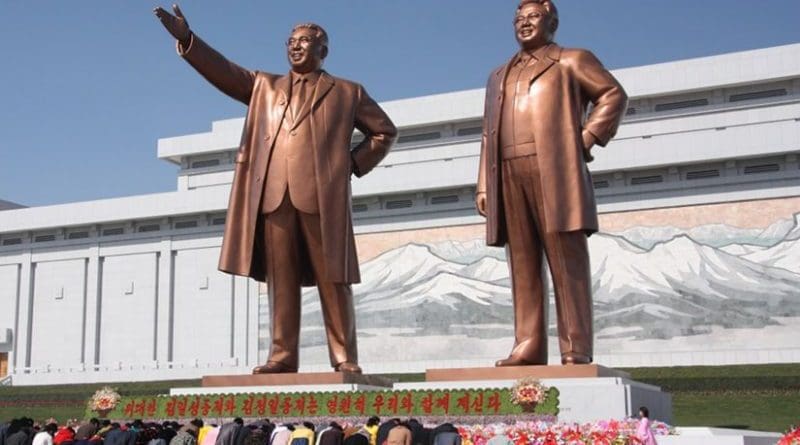North Korea A Hermit Kingdom Again – Analysis
By Andrei Lankov*
The year 2021 was a time of acute crisis and radical changes in North Korean policy — mostly for the worse.
The impact of the COVID-19 pandemic looms large. In early 2020, the North Korean government decided to close its borders completely and then maintained a level of quarantine control that would be unthinkable elsewhere. Passenger traffic came to a nearly complete halt and the volume of cargo traffic decreased to a fraction of what it used to be. While North Korea continued to receive food, fuel and fertilizer from China (largely as humanitarian aid in undisclosed quantities) regular foreign trade collapsed.
Authorities claim that not a single case of COVID-19 has been discovered in the country. While these reports are misleading, cases remained isolated.
But success mitigating COVID-19 came at a great price. Being deprived of any chances to engage in foreign trade, the North Korean economy began to shrink. By late 2021, in some remote parts of the country, malnutrition became common and starvation deaths began to occur. Nonetheless, it seems that Chinese aid is helping to keep the country afloat and will probably prevent a full-scale humanitarian disaster.
At the same time, the North Korean government was remarkably reluctant to accept foreign vaccines, even though such medical aid was repeatedly proposed by foreign aid agencies.
Since 2021, North Korea’s policy of self-isolation, which was often sloppily enforced since the late 1990s, began to be implemented with an energy that has not been seen since the 1970s. North Korea is turning into a ‘hermit state’ again. New fences equipped with CCTV cameras were built alongside the border, making defection and border crossing almost impossible. As a result, the number of North Korean defectors arriving in South Korea decreased dramatically, from roughly 1000 in pre-COVID-19 years to less than 70 in 2021.
Since around 2000, North Koreans were active consumers of Western and South Korean pop culture. They listened to K-pop, watched foreign movies and TV dramas. This is not the case anymore as North Korean authorities succeeded in reducing the availability of foreign media products. In December 2020, the Supreme People’s Assembly passed a new law which introduced extremely harsh punishments — up to death sentences — for selling, possessing, consuming and reproducing ‘products of a reactionary culture’.
On the international front, North Korea is drawing huge benefits from the US–China rivalry.
The confrontation with the United States made China see North Korea as a highly valuable buffer zone. Now, China is now determined to preserve the status quo in the northern part of the Korean Peninsula. Beijing does not want to deal with instability, revolution or a coup, and is not happy about possible unification of the Korean Peninsula under Seoul’s auspices. In the new strategic situation, China is willing to provide North Korea with modest aid which will be sufficient to prevent an outbreak of famine.
Few conditions are likely to be attached to this aid, but there might be a request not to be excessively provocative, avoiding nuclear tests and ICBM launches. Throughout 2021, North Korea kept to the unilateral moratorium of nuclear tests and the ICBM launches it first introduced in early 2018, but still demonstrated the remarkable achievements of its military engineers. Its nuclear reactor and petrochemical laboratories resumed operation, producing weapons-grade plutonium, while production of highly enriched uranium never stopped. On top of that, the North Korean military tested a number of impressive new weapons systems, including a long-range cruise missile, a train-based ballistic missile transporter erector launcher and a prototype supersonic glider.
The presence of Chinese aid means that North Korea can rely on external support for its economic survival. Fully understanding this, the North Korean government lost interest in market-oriented reforms that Kim Jong-un and his advisors had implemented until recently. The 8th Congress of the Korean Workers’ Party introduced new economic policies in January 2021 which aim at the revival of the old Leninist/Stalinist centrally planned economy. It’s not clear whether such plans can be executed fully — markets are way too important for the daily life of North Korea. But the intention is clear.
Given that the US–China rivalry is likely to last for a long time, North Korea is in a state of equilibrium. Relying on Chinese aid, maintaining the strictest self-isolation possible and trying to increase the role of the state in both the economy and society while also further advancing its nuclear and missile programs, North Korea will, to an extent, freeze itself. It will likely remain in such a frozen state for a significant period of time. The early years of Kim’s rule, full of risky diplomacy, bold economic reforms and promises of jolly life seem to be over.
*About the author: Andrei Lankov is Professor at Kookmin University, Seoul, and Director of NK News.
Source: This article is published by East Asia Forum and part of an EAF special feature series on 2021 in review and the year ahead.

